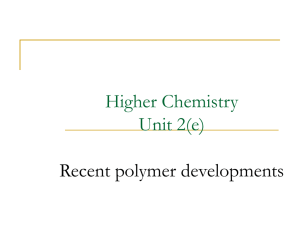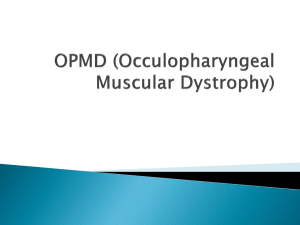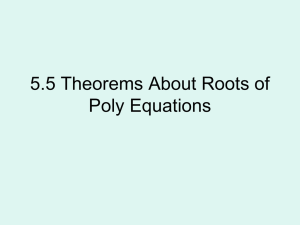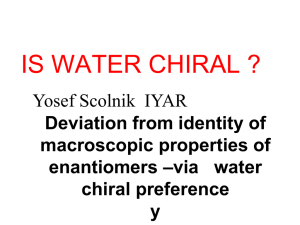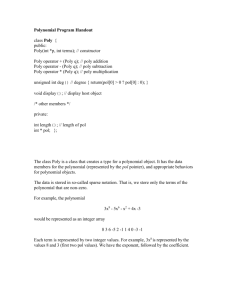IlTodorov_slides
advertisement
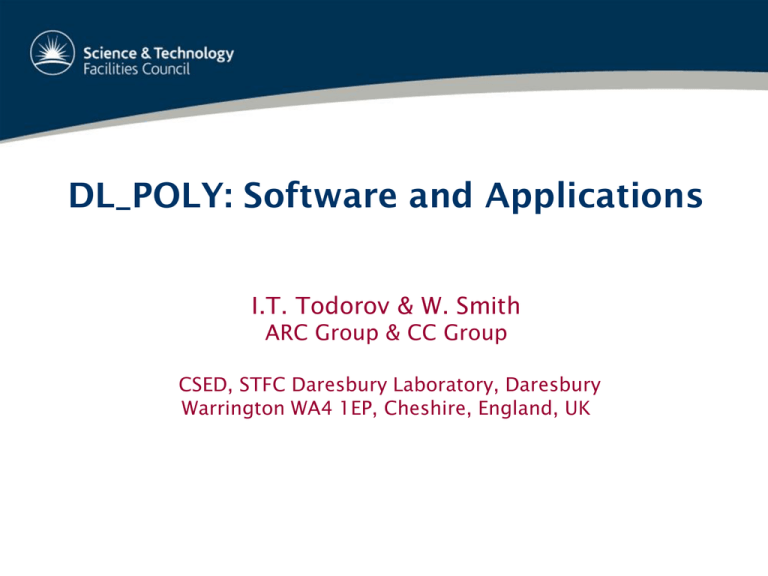
DL_POLY: Software and Applications I.T. Todorov & W. Smith ARC Group & CC Group CSED, STFC Daresbury Laboratory, Daresbury Warrington WA4 1EP, Cheshire, England, UK Where is Daresbury? Molecular Dynamics: Definitions • Theoretical tool for modelling the detailed microscopic behaviour of many different types of systems, including gases, liquids, solids, surfaces and clusters. • In an MD simulation, the classical equations of motion governing the microscopic time evolution of a many body system are solved numerically, subject to the boundary conditions appropriate for the geometry or symmetry of the system. • Can be used to monitor the microscopic mechanisms of energy and mass transfer in chemical processes, and dynamical properties such as absorption spectra, rate constants and transport properties can be calculated. • Can be employed as a means of sampling from a statistical mechanical ensemble and determining equilibrium properties. These properties include average thermodynamic quantities (pressure, volume, temperature, etc.), structure, and free energies along reaction paths. DL_POLY Project Background • General purpose parallel (classical) MD simulation software • It was conceived to meet the needs of CCP5 - The Computer Simulation of Condensed Phases (academic collaboration community) • Written in modularised Fortran90 (NagWare & FORCHECK compliant) with MPI2 (MPI1+MPI-I/O) fully self-contained • 1994 – 2011: DL_POLY_2 (RD) by W. Smith & T.R. Forester (funded for 6 years by EPSRC at DL) -> DL_POLY_CLASSIC • 2003 – 2011: DL_POLY_3 (DD) by I.T. Todorov & W. Smith (funded for 4 years by NERC at Cambridge) -> DL_POLY_4 • Over 11,000 licences taken out since 1994 • Over 1000 registered FORUM members since 2005 • Available free of charge (under licence) to University researchers (provided as code) and at cost to industry DL_POLY_DD Development Statistics DL_POLY_DD Licence Statistics DL_POLY Licence Statistics DL_POLY Licence Statistics DL_POLY Licence Statistics DL_POLY Project Current State • January 2011: DL_POLY_2 -> DL_POLY_CLASSIC on a BSD type Licence (BS retired but supporting GUI and fixes) • October 2010: DL_POLY_3 -> DL_POLY_4 still under STFC Licence, over 1300 licences taken out since November 2010 • Rigid Body dynamics • Parallel I/O & netCDF I/O – NAG dCSE (IJB & ITT) • CUDA+OpenMP port (source, ICHEC) & MS Windows port (installers) • SPME processor grid freed from 2^N decomposition – NAG dCSE (IJB) • Load Balancer development (LJE, finished 30/03/2011) • Continuous Development of DL_FIELD (pdb to DLP I/O, CY) Current Versions • DL_POLY_4 (version 1.2) – Dynamic Decomposition parallelisation, based on domain decomposition but with dynamic load balancing – limits up to ≈2.1×109 atoms with inherent parallelisation. – Full force field and molecular description with rigid body description – Free format (flexible) reading with some fail-safe features and basic reporting (but fully fool-proofed) • DL_POLY Classic (version 1.6) – Replicated Data parallelisation, limits up to ≈30,000 atoms with good parallelisation up to 64 (system dependent) processors (running on any processor count) – Full force field and molecular description – Hyper-dynamics: Temperature Accelerated Dynamics & Biased Potential Dynamics, Solvation Dynamics – Spectral Shifts, Metadynamics, Path Integral MD – Free format reading but somewhat strict Supported Molecular Entities Rigid molecules Point ions and atoms Flexibly linked rigid molecules Polarisable ions (core+ shell) Flexible molecules Rigid bonds Rigid bond linked rigid molecules Force Field Definitions – I • particle: rigid ion or atom (charged or not), a core or a shell of a polarisable ion(with or without associated degrees of freedom), a massless charged site. A particle is a countable object and has a global ID index. • site: a particle prototype that serves to defines the chemical & physical nature (topology/connectivity/stoichiometry) of a particle (mass, charge, frozen-ness). Sites are not atoms they are prototypes! • Intra-molecular interactions: chemical bonds, bond angles, dihedral angles, improper dihedral angles, inversions. Usually, the members in a unit do not interact via an inter-molecular term. However, this can be overridden for some interactions. These are defined by site. • Inter-molecular interactions: van der Waals, metal (EAM, Gupta, Finnis-Sinclair, Sutton-Chen), Tersoff, three-body, four-body. Defined by species. Force Field Definitions – II • Electrostatics: Standard Ewald*, Hautman-Klein (2D) Ewald*, SPM Ewald (3D FFTs), Force-Shifted Coulomb, Reaction Field, Fennell damped FSC+RF, Distance dependent dielectric constant, Fuchs correction for non charge neutral MD cells. • Ion polarisation via Dynamic (Adiabatic) or Relaxed shell model. • External fields: Electric, Magnetic, Gravitational ,Oscillating & Continuous Shear, Containing Sphere, Repulsive Wall. • Intra-molecular like interactions: tethers, core shells units, constraint and PMF units, rigid body units. These are also defined by site. • Potentials: parameterised analytical forms defining the interactions. These are always spherically symmetric! • THE CHEMICAL NATURE OF PARTICLES DOES NOT CHANGE IN SPACE AND TIME!!! Force Field by Sums V( r1 , r2 ,....., rN ) N' U pair (| ri rj |) i, j N' U Tersoff ri , rj , rk i, j, k ε metal N' V (| r rj |) pair i i, j U bond i bond i b on d U 3 body U dihed ri , rj , rk , ra , rb N' U 4 body ri , rj , rk , rn N' F ρ ij (| ri rj |) i, j N i N ang le U angle i angle , ra , rb , rc i dihed , ra , rb , rc , rd N in v ers U invers i invers , ra , rb , rc , rd i in v ers N teth er i teth er i, j i, j, k, n i d ih ed q iq j | ri rj | i ang le N d ih ed 4π 0 N' i, j, k N b on d N' 1 U tether i tether , rt , rt 0 N core -sh ell i core -sh ell U core - shell i core - shell , | ri rj | N i 1 Φ external ri Ensembles and Algorithms Integration: Available as velocity Verlet (VV) or leapfrog Verlet (LFV) generating flavours of the following ensembles • NVE • NVT (Ekin) Evans • NVT Andersen^, Langevin^, Berendsen, Nosé-Hoover • NPT Langevin^, Berendsen, Nosé-Hoover, MartynaTuckerman-Klein^ • NT/NPnAT/NPnT Langevin^, Berendsen, NoséHoover, Martyna-Tuckerman-Klein^ Constraints & Rigid Body Solvers: • VV dependent – RATTLE, No_Squish, QSHAKE* • LFV dependent – SHAKE, Euler-Quaternion, QSHAKE* Assumed Parallel Architecture DL_POLY is designed for homogenious distributed parallel machines M0 P0 P4 M4 M1 P1 P5 M5 M2 P2 P6 M6 M3 P3 P7 M7 Replicated Data A B C D Initialize Initialize Initialize Initialize Forces Forces Forces Forces Motion Motion Motion Motion Statistics Statistics Statistics Statistics Summary Summary Summary Summary P0Local force terms P1Local force terms P2Local force terms Processors Molecular force field definition Global Force Field Bonded Forces within RD RD Scheme for long-ranged part of SPME U. Essmann, L. Perera, M.L. Berkowtz, T. Darden, H. Lee, L.G. Pedersen, J. Chem. Phys., (1995), 103, 8577 1. 2. 3. 4. 5. 6. 7. 8. 9. 10. 11. Calculate self interaction correction Initialise FFT routine (FFT – 3D FFT) Calculate B-spline coefficients Convert atomic coordinates to scaled fractional units Construct B-splines Construct charge array Q Calculate FFT of Q array Construct array G Calculate FFT of G array Calculate net Coulombic energy Calculate atomic forces Domain Decomposition 21 A B C D P0Local atomic indices Tricky! P1Local atomic indices P2Local atomic indices Processor Domains Molecular force field definition Global force field Bonded Forces within DD DD Scheme for long-ranged part of SPME U. Essmann, L. Perera, M.L. Berkowtz, T. Darden, H. Lee, L.G. Pedersen, J. Chem. Phys., 103, 8577 (1995) 1. 2. 3. 4. 5. 6. 7. 8. 9. 10. 11. Calculate self interaction correction Initialise FFT routine (FFT – IJB’s DaFT: 3M2 1D FFT) Calculate B-spline coefficients Convert atomic coordinates to scaled fractional units Construct B-splines Construct partial charge array Q Calculate FFT of Q array Construct partial array G Calculate FFT of G array Calculate net Coulombic energy Calculate atomic forces I.J. Bush, I.T. Todorov, W. Smith, Comp. Phys. Commun., 175, 323 (2006) Performance Weak Scaling on IBM p575 2005-2011 Solid Ar (32'000 atoms per CPU) NaCl (27'000 ions per CPU) SPC Water (20'736 ions per CPU) 1000 800 Speed Gain fec r pe n tio a s eli l l a 33 million atoms ar p t 28 million atoms 600 400 21 million atoms n allelisatio r a p d o o g 200 max load max load max load 0 0 200 400 600 Processor Count 700'000 atoms per 1GB/CPU 220'000 ions per 1GB/CPU 210'000 ions per 1GB/CPU 800 1000 Rigid Bodies versus Constraints 450,000 particles with DL_POLY_4 Scaling 10 9 ICE7 steps per second 8 ICE7_CB 7 6 5 4 3 2 1 0 0 100 200 300 Np 400 500 600 I/O Weak Scaling on IBM p575 2005-2007 800 Solid Ar dashed lines show shut-down times NaCl solid lines show start-up times SPC Water Time [s] 600 400 200 0 0 200 400 600 Processor Count 800 1000 Benchmarking BG/L Jülich 2007 Perfect MD step total Link cells van der Waals Ewald real Ewald k-space 16000 14000 Speed Gain 12000 10000 8000 6000 4000 14.6 million particle Gd2Zr2O7 system 2000 2000 4000 6000 8000 10000 Processor count 12000 14000 16000 Benchmarking XT4/5 UK 2010 Perfect MD step total Link cells van der Waals Ewald real Ewald k-space 8000 7000 Speed Gain 6000 5000 4000 3000 2000 14.6 million particle Gd2Zr2O7 system 1000 1000 2000 3000 4000 5000 Processor count 6000 7000 8000 Benchmarking on Various Platforms 9 8 6 -1 Evaluations [s ] 7 CRAY XT4 SC CRAY XT4 DC CRAY XT3 SC / IBM P6+ CRAY XT3 DC BG/L BG/P IBM p575 3GHz Woodcrest DC 5 4 3 2 1 3.8 million particle Gd2Zr2O7 system 0 0 500 1000 Processor count 1500 2000 Importance of I/O - I Types of MD studies most dependent on I/O • Large length-scales (109 particles), short time-scale such as screw deformations • Medium big length-scales (106–108 particles), medium time-scale (ps-ns) such as radiation damage cascades • Medium length-scale (105–106 particles), long time-scale (ns-s) such as membrane and protein processes Types of I/O: portable • ASCII + • Binary – • XDR Binary + human readable + – – loss of precision – + + size – + + Importance of I/O - II Example: 15 million system simulated with 2048 MPI tasks MD time per timestep ~0.7 (2.7) seconds on Cray XT4 (BG/L) Configuration read ~100 sec. (once during the simulation) Configuration write ~600 sec. for 1.1 GB with the fastest I/O method – MPI-I/O for Cray XT4 (parallel direct access for BG/L). BG/L 16,000 MPI tasks – MD time per timestep 0.5 sec. with a configuration write a frame ~18,000 sec. I/O in native binary is only 3-5 times faster and 3-7 times smaller Some unpopular solutions • Saving only the important fragments of the configuration • Saving only fragments that have moved more than a given distance between two consecutive dumps • Distributed dump – separated configuration in separate files for each MPI task (CFD) I/O Solutions in DL_POLY_4 1. Serial read and write (sorted/unsorted) – where only a single MPI task, the master, handles it all and all the rest communicate in turn to or get broadcasted to while the master completes writing a configuration of the time evolution. 2. Parallel write via direct access or MPI-I/O (sorted/unsorted) – where ALL / SOME MPI tasks print in the same file in some orderly manner so (no overlapping occurs using Fortran direct access printing. However, it should be noted that the behaviour of this method is not defined by the Fortran standard, and in particular we have experienced problems when disk cache is not coherent with the memory). 3. Parallel read via MPI-I/O or Fortran 4. Serial NetCDF read and write using NetCDF libraries for machine-independent data formats of array-based, scientific data (widely used by various scientific communities). Performance for 216,000 Ions of NaCl on XT5 MPI-I/O Write Performance for 216,000 Ions of NaCl on XT5 3.09 3.10 3.09 3.10 Cores I/O Procs Time/s Time/s Mbyte/s Mbyte/s 32 32 143.30 1.27 0.44 49.78 64 64 48.99 0.49 1.29 128.46 128 128 39.59 0.53 1.59 118.11 256 128 68.08 0.43 0.93 147.71 512 256 113.97 1.33 0.55 47.60 1024 256 112.79 1.20 0.56 52.47 2048 512 135.97 0.95 0.46 66.39 MPI-I/O Read Performance for 216,000 Ions of NaCl on XT5 3.10 New 3.10 New Cores I/O Procs Time/s Time/s Mbyte/s Mbyte/s 32 16 3.71 0.29 17.01 219.76 64 16 3.65 0.30 17.28 211.65 128 32 3.56 0.22 17.74 290.65 256 32 3.71 0.30 16.98 213.08 512 64 3.60 0.48 17.53 130.31 1024 64 3.64 0.71 17.32 88.96 2048 128 3.75 1.28 16.84 49.31 DL_POLY Project Background • Rigid body dynamics and decomposition freed SPME • no topology and calcite potentials • Fully parallel I/O: reading and writing in ASCII, optionally including netCDF binary in AMBER format • CUDA (ICHEC) and Windows ports • New GUI (Bill Smith) • Over 1,300 licences taken out since November 2010 • DL_FILED field builder (Chin Yong) – 300 licencesc DL_FILED • AMBER & CHARM to DL_POLY • OPLSAA & Drieding to DL_POLY xyz, PDB Protonated DL_FIELD ‘black box’ FIELD CONFIG DL_POLY Roadmap • August 2011 – March 2012: PRACE-1IP-WP7 funds effort by ICHEC towards CUDA+OpenMP port, SC@WUT towards OpenCL+OpenMP port, and FZ Julich for FMP library testing • October 2011 – October 2012: EPSRC’s dCSE funds effort by NAG Ltd. • OpenMP within MPI vanilla • Beyond 2.1 billion particles • October 2011 – September 2012: 2 Temperature Thermostat Models, Fragmented I/O, On-the-Fly properties • November 2011 – September 2013: MMM@HPC, Gentle thermostat, Hyperdynamics Acknowledgements Thanks to • Bill Smith (retired) • Ian Bush (NAG Ltd.) • Christos Kartsaklis (ORNL), Ruairi Nestor (ICHEC) http://www.ccp5.ac.uk/DL_POLY/



